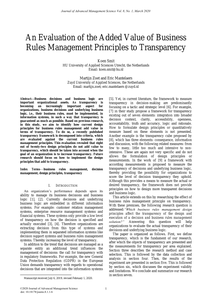Een stappenplan om de communicatie tussen huisarts en fysiotherapeut te optimaliseren in het kader van de directe toegankelijkheid fysiotherapie
DOCUMENT
Op basis van onderzoek wordt een stappenplan beschreven met als doel de communicatie tussen huisarts en fysiotherapeut te optimaliseren in het kader van Directe Toegankelijk Fysiotherapie
DOCUMENT
Business decisions and business logic are important organizational assets. As transparency is becoming an increasingly important aspect for organizations, business decisions and underlying business logic, i.e., their business rules, must be implemented, in information systems, in such a way that transparency is guaranteed as much as possible. Based on previous research, in this study, we aim to identify how current design principles for business rules management add value in terms of transparency. To do so, a recently published transparency framework is decomposed into criteria, which are evaluated against the current business rules management principles. This evaluation revealed that eight out of twenty-two design principles do not add value to transparency, which should be taken into account when the goal of an organization is to increase transparency. Future research should focus on how to implement the design principles that add to transparency.
DOCUMENT
